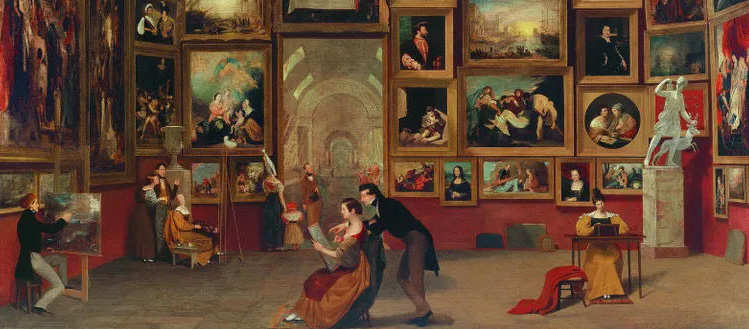Source: Avant Arte.
So, you’re an art lover. Either you buy art, or you’d like to – but where to channel this passion? You’re in the right place. This guide covers everything you need to kickstart, develop and deepen a collection.
Know that humans love to collect
Humans have always been collectors. As hunter gatherers, it was a matter of survival. Before the internet, it was a matter of cultural status. Things like gig tickets, Pokemon cards and CDs all had their own meanings and importance in subcultures around the world.
Collecting art is no different. It’s both a totally ordinary and totally extraordinary thing to do. Yes, the price tag is higher. Yes, there are histories of elitism which have put some people off the idea of collecting art. But all of that is changing. What remains the same is the core human desire to collect. There’s something infinitely exciting and comforting about building a picture of your life through objects and artefacts you find along the way.
I guess most childhoods are relatively similar – of my era anyway. Growing up I was obsessed with wrestling figures, and to this day it still makes me happy to hold them. Art is kind of the same.
Ben, Head of Creative Production at Avant Arte
Forget the stereotypical art collector
When you hear the phrase ‘art collector’ who do you see? If you see heirs and tycoons in mansions or private jets, you’re not alone. Many people have preconceptions about collectors. But rest assured, the very foundations of these stereotypes are crumbling in the art world and beyond.
In our 2024 Collector Report: The New Generation of Art Collectors, we found that our collector community shares one core value: a love and passion for art. We also found that almost half of our collector community are aged under 40 and that they’re spread across many corners of the globe – bucking the stereotype that collecting happens in an ageing, European environment. Whatever stage you’re at on your collecting journey, ask yourself this: Why do I collect? What brings me joy? How, ultimately, will I collect on my own terms?
Most people would not define themselves as an art collector, but will nonetheless have a collection of some kind. It can be something consciously cultivated, but also something that happens by accident.
Anonymous collector – one of almost 1500 who contributed to our first collector report
Love your collection
We think it’s important that you love the art you buy, and so do our collectors. Go with your gut. Trust your instincts. Buy art that genuinely excites you.
Once you’ve bought your work of art, remember that love is an action too. Frame your art. Protect it from sunlight. Treat it with care. Make an inventory. Document your pieces. Let your collection be with you in the quiet mundane moments as well as the highs and lows of life. The more you appreciate it, the more your collection will uplift and empower you.
Be frank about money
We know that a passion for art is the most important part of being a collector. But we also know that money is a big part of collecting too – whether spending it, or making it.
It’s important not to shy away from honest conversations with yourself, and whoever you may share financial responsibility with. It can be useful to make a realistic budget for what you can spend, annually, quarterly and monthly. This way you have a clear and flexible framework so that you can invest your time, creativity and hard-earned cash in the best possible way.
Play the long game
There’s always a financial risk when you invest. One solution is to buy art you love, and then its value will go beyond the price tag. Nonetheless, we know that collectors want to build collections that retain or increase their value. What’s important to remember is that the most sustainable form of growth is slow and gradual. Overnight wins may seem appealing, but they won’t always contribute to the long-term value of your collection. It can take years, even decades, to build, so buckle up and commit to the journey.
Everyone wants to discover the next big thing, but to be a collector, there’s this kind of longevity to it. You actually have to be patient if you want to build a collection that not only you love but holds or increases its value.
Sofiya, Art Advisor at Avant Arte
Get to grips with primary and secondary markets
Primary market
When an artwork is sold for the first time, it’s sold on the primary market. Primary sales tend to be made by a gallery representing the artist, the artist themselves or an edition partner – like Avant Arte.
Secondary market
When an artwork is sold for the second time and any other time after that, it’s sold on the secondary market. Secondary sales tend to be made by auction houses, and collectors who are selling pieces from their own collection.
Our main tip is to research the price of an artist’s work on both their primary and secondary markets before you buy something. Bear in mind that galleries can be quite secretive about pricing, so you may have to do some digging. Another thing that’s good to remember is that, in most cases, an artist will make money from a primary sale, but not from a secondary sale. It’s worth considering where you want your money to go and who you want to support.
When it comes to NFTs, researching an artist’s primary and secondary market is much more transparent. The blockchain records all transactions and makes them visible, so you can see a full history of sales. Plus, artists continue to make money on the secondary market. This transparency is why many collectors and artists feel that NFTs allow a more ethical approach than the traditional art world.
Collect responsibly (don’t flip)
‘Flipping’ is when someone buys an artwork on the primary market and swiftly resells it on the secondary market for a higher price, taking the profit for themselves. While this might seem like a good way to make some cash, it’s generally frowned upon as it’s seen to intentionally exploit the fact that artists largely don’t make money from secondary sales. On top of this, it can have a damaging effect on an artist’s market.
That said, it’s also totally natural for your time with an artwork to come to an end. The key thing is to be conscious and intentional with how you buy and sell, and always keep the artist in mind.
It sounds appealing to sell artworks quickly at higher and higher prices, but this can create a bubble in an artist’s market, which ultimately bursts.
Sofiya, Art Advisor at Avant Arte
Take pricing with a pinch of salt
The ultimate paradox of being a collector is that art is priceless but is also given a price. Its monetary value can feel confusing, arbitrary even, so it’s good to know some of the factors that determine the price of an artwork.
The artist
Prices tend to be higher for more established artists and for dead artists. Buzz around more up-and-coming artists who are having their moment can also cause an increase in the prices of their works.
Rarity and provenance
If an artwork is very rare, or represents an artist’s signature style, it tends to be more sought after and therefore more expensive. This applies to both physical and digital art.
Physical attributes
Material, size, and how much time it took to create, for example. Sometimes the first two factors can make this factor seem less important, but it’s still at play and will be most apparent when you compare the prices of artworks by the same artist.
Support artists and institutions you care about
If you love art, then you’ll want to be part of an exciting, nourishing and diverse art world full of opportunities to experience art in new ways. Without community, without access and without the avant garde, art would get pretty boring pretty fast.
Investing in the places and people who bring art to life is a fantastic way to invest in the long-term wellbeing of yourself and the art world. With so many artists and institutions to support, it can feel like you might miss something important. And chances are, you will. (Sorry!) But if you trust your gut, you may well find some future stars along the way – and when you do, it will be all the more satisfying because they’ll be the ones building the kind of art world you want to see.
Don’t limit yourself to original works
Art is abundant. There are so many different types of art you can collect – from prints and NFTs to works on paper and paintings, sculptures or even jars of condoms. Sometimes exploring new avenues can be the perfect way to unlock your collection. That said, if you’re feeling overwhelmed by the sheer breadth of what’s on offer, sometimes it can be helpful to give yourself a theme or focus. Author and curator Gemma Rolls Bentley, for instance, focuses her collection on artworks by queer artists.
Cultivate your taste, see art in the flesh
As a collector, your taste is your most precious asset. Likelihood is that you already enjoy cultivating it – and the internet is a wonderful and inspiring place to connect with art and art lovers. But with the fast pace of life, it can be easy to forget the fun of real world interactions and experiences. Try to visit an artist in their studio, make a trip to a gallery or museum, and find ways to bring your online community together in person.
By embracing the joys of the internet alongside the joys of being out in the world, art can become an even bigger part of your life.








